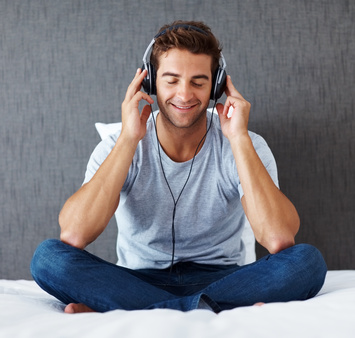
by Peter Winslow
I recently fielded this question from a very thoughtful member of our AS Victors group:
“Can repression of identity cause pain? The internal conflict is deep… but I sense I am on a path of awakening. I long for the purest form of freedom.”
To the question, the answer is absolutely, positively, undeniably yes—repression of identity can cause pain. The body’s first signal is usually electromagnetic and can be recognized in an emotional state. If ignored long enough, it can develop into chronic pain and disease of one kind or another. In my book Help For People With Ankylosing Spondylitis I elaborate on this and cite the clinical studies that document these findings.
Following is an excerpt from my book Heal For Real which addresses the issue directly:
Disease requires us to stop distracting ourselves and shift our efforts and attention. Some diseases force us to put our lives on hold and focus solely on the condition. This is the primary function and purpose of disease. That’s right, disease has a purpose. The purpose of disease is to make you pay attention to what is really important.
As we already know, chronic illness is often caused and exacerbated by chronic stress. Here’s a powerful insight: emotional stress can be caused by an inner conflict between the determination, and the free will of the individual. That means a struggle between the “ego” or head, and the “soul” or heart of the person.
When your “head” and your “heart” are pulling you in different directions, the inner conflict creates chronic stress which roots itself deeply into the subconscious mind. An example might be giving up your lifelong dream, so you can remain in a mundane job that offers stability. When an emotional issue like this remains unknown or ignored, the symptoms of pain or dis-ease can arise, come to call your attention to the conflict raging on deeper levels of your consciousness.
That’s when people may feel trapped, victimized, with little choice in the matter. They don’t know what to do but put their energy and attention into a self-image of struggle and suffering, even living and dying with the symptoms of an “incurable” illness.
The mission for these people is epic: to discover and act upon how the dis-ease actually serves them, and learn what it can bring to their lives in terms of inner healing, personal growth and spiritual wisdom.
I believe your condition carries a profound message. Dis-ease appeared because you are ready for change, perhaps ready to make peace with yourself. Rather than act like a hapless victim, choose to see it differently. Consider your condition as the gateway to a path of personal empowerment.
You fell ill for a reason, and the reason may be this: There is a divine message trying to get through to you. Choose to recognize your dis-ease as part of that process, a messenger which can guide you back to wholeness.
Reframe your attitude and consider your condition, debilitating as it is, to be in the interest of your own greatest good. This decision can help bring relief and resolve to your deep inner conflicts, regardless of what happens in the body.
With the shift in awareness, the ill condition will abate, and you emerge the stronger for it. Thus is the purpose of dis-ease accomplished. It may now leave you in peace.
The condition you once viewed as needless suffering is revealed for what it really is—a messenger from the most high, illuminating the dim vistas of your darkness, thrusting you upon the altar of your life’s purpose, right here and now in this present moment.
Take heart, feel gratitude and sense a powerful rejuvenation flow through you, for very few of your efforts and adventures will give you this enormous opportunity for freedom—authentic personal freedom—the quest of every soul and sentient being.
Peter

by Peter Winslow
We all know that by managing our stress more effectively, we can more easily reverse the symptoms of chronic pain.
Enter meditation. Practicing meditation is an ideal solution for reducing your stress and easing your symptoms. It can be as easy as taking a few minutes to concentrate, and as simple as closing your eyes and watching your breath.
Let’s look at some of the ways meditation can help you:
- Meditation diverts attention away from pain. Concentrating on pain creates more of it. And the more you focus on it, you more you feel it. Directing your attention away from pain is clinically proven to relieve it, and meditation is a superior way to do that.
- Meditation helps reverse symptoms of chronic illness. It generates more oxygen, lowers blood pressure, and reverses stress in a number of ways. These are physical changes which alleviate pain and stress, and will reduce the symptoms of Ankylosing Spondylitis.
- Meditation relaxes you. It decreases metabolism and improves heart function while normalizing breathing patterns and brain waves. The mind is uncluttered and cleared of stress, which increases cognitive function and promotes a deeper sense of wellbeing.
- Meditation wards off illness and infection. Meditation is a powerful immune booster. Untreated stress damages your body and harms immune function, leaving you more vulnerable to illness and injury. When you relax and de-stress regularly, you are less prone to disease and discomfort.
- Meditation improves overall health. Brain scans have shown that meditation produces long-term improvements in metabolic function, heart rate, attention, memory, learning and mental perception.
And—did I mention? There are tremendous emotional benefits that come with meditation too. You’ll feel more present, more positive and more confident, all while cultivating true peace of mind. These in turn enhance your ability to reverse the pain and symptoms of Ankylosing Spondylitis.
For help and guidance with meditation and mental imagery, check out the free resources available to you here on HelpingHealing.com.
To your improving health –
Peter

by Peter Winslow
Studies now prove that your emotions are inextricably linked to your physical well-being.
Think of how your blood pressure rises significantly when you feel anxious or threatened. High blood pressure has become a major problem for many people, and it’s a pretty clear example of what is called the mind-body connection.
When emotional health is unbalanced, it consumes a huge amount of your energy. Negative emotions take many forms which work their way to the surface as anger, depression, anxiety, jealousy, envy, rage, passive aggressive behavior, and a host of other moods.
Common sources of chronic stress are bad memories of the past and anxiety and worries about the future. I find it interesting to note these major contributors to ill health are no more than phantom thoughts about events and circumstances that aren’t even happening at the present time, and may never happen at all.
When you consider major stress, you might think of life-disrupting events like a death in the family, loss of a job, divorce, a case of identity theft or a significant financial loss. But actually, the most common stressors in life come in little packages: deadlines that have to be met, the milk glass that broke at dinner, yard work that keeps piling up, the phone call you need to make but don’t want to.
Day-to-day hassles like these usually don’t feel terribly stressful, and by themselves they don’t make much of an impact on overall emotional well-being. But research says that it’s the little daily stresses that affect your health the most and even make you more susceptible to serious illness and disease.
Recent scientific studies suggest that, taken together, every day hassles and annoyances may be the biggest threat of all. The overdue phone calls, minor accidents and unfinished business add up to major, chronic stress – and that can lead to conditions like diabetes, heart disease, stroke and cancer.
Depression is another clear example of an emotional imbalance. There are lots of forms of it, such as genetic, hormonal, situational or chemical, but in all cases depression is caused or exacerbated by negative thought patterns.
Negative thought patterns create a “chemical cascade” in the body, the domino effect of neurotransmitters and other chemicals as they surge through the brain and direct other chemicals to excrete into the body in a chain-reaction response to the thought.
Doctors can alter or block the brain chemistry with pharmaceutical drugs and other forms of treatment that are intended to interrupt the feedback loop between the thoughts and the chemistry that the thoughts have created. But when the treatment fades, the symptoms often return.
A combination of medication and therapy is considered by most doctors to be the best treatment for most types of depression but only a small percentage of the people who need it will ever get it.
In most cases, counseling and cognitive behavioral therapies go overlooked or ignored. These methods require the patient to make a commitment to take at least some responsibility for their own condition and to do their part in the healing process, and many are reticent to go there. Until they do, the condition will continue to plague the mind and body of the individual, and chronic illness is the eventual result.
Peter

by Peter Winslow
Each individual has the ability to improve his or her health. One way to do it is by tapping into your own resources. There are many tools to access these inner resources and enhance your life with greater health, happiness and harmony.
Periodically, I like to share some of the recent scientific studies I see in this area. I hope you find them inspiring!
Through the Center For Mind-Body Medicine eighty-two high school students in Kosovo participated in a randomized-controlled study which concluded that “…all students had experienced post traumatic stress, flashbacks, nightmares, and symptoms of withdrawal and numbing in the war-torn area of Kosovo where 90% of the homes were burned and bombed and 20% of the children lost one or both parents.” The small group settings used meditation, guided imagery, breathing techniques and biofeedback as well as self-expression through words, drawings, and movement. Following the program, the number of students having symptoms indicating post traumatic stress disorder was significantly reduced from 100% to 18%.
Johns Hopkins Center for Complementary and Alternative Medicine (“CAM”) reported in a survey the following statistics relating to the use of complementary and alternative therapies (referred to as “CAM”):
- “40% of Americans use some form of complementary or alternative therapy for chronic conditions;
- CAM was most frequently used for pain control, and nearly 50% reported using CAM because their prescribed medications were ineffective;
- more than half of these patients used dietary supplements or herbal therapies, and almost two-thirds of the patients found CAM to be helpful; and
- 30% to 70% of cancer patients who are inadequately treated by their physicians turn to CAM in the hope of curing or alleviating their pain.”
Also supporting the use of complimentary and alternative therapies is a study of 23,000 adults by the National Institute of Health’s National Center for Complementary and Alternative Medicine. See the study.
Study on Aging by Harvard Psychologist Ellen Langer concluded that thoughts about how old you are affect how old or young you feel and how your body responds, as reported in Newsweek. Subjects were put into an environment to simulate living 20 years ago; the participants actually felt as if their age had been turned back two decades. Outside observers noted that the subjects appeared to be younger and healthier than they were before the experiment.
The Johns Hopkins Medicine and Digestive Center reports the following excerpts from a summary of integrative psychotherapy:
“We know that our minds can quickly jump to worst-case scenarios, worry, and self-defeating behaviors. We can feel overwhelmed… these thought patterns can lead to illness … as patients come to understand what triggers their pain, anxiousness… old patterns lose their hold… enabling changes… to move beyond prior limitations of thought and attitude.” Read entire article.
Note: By providing links to other sites, the AS Victors Club does not endorse, approve or guarantee any of the products or the information available from those sites.

by Peter Winslow
The body’s natural relaxation response is a powerful antidote to stress. Techniques like deep breathing, visualization, progressive muscle relaxation, meditation, and yoga activate relaxation in the body and mind. With regular practice, these techniques reduce stress levels and boost feelings of joy and inner connectedness. They also condition you to stay calm and collected in the face of adversity.
You can’t always avoid stress, but you can counteract its negative effects by using the “relaxation response” – a state of calmness which is the polar opposite of the stress response.
The stress response floods your body with chemicals that prepare you for “fight or flight.” While the stress response is necessary in emergency situations, it wears your mind and body down when constantly activated by daily activities. The relaxation response brings your system back into balance by metabolizing stress hormones in the bloodstream, slowing the heart rate, lowering blood pressure and relaxing the tension in your muscles.
In addition to its calming mental and physical effects, research shows that the relaxation response increases energy and focus, protects against illness, relieves aches and pains, heightens problem-solving abilities, and boosts motivation and productivity. Best of all, it is very easy to learn and everyone can do it.
Peter





